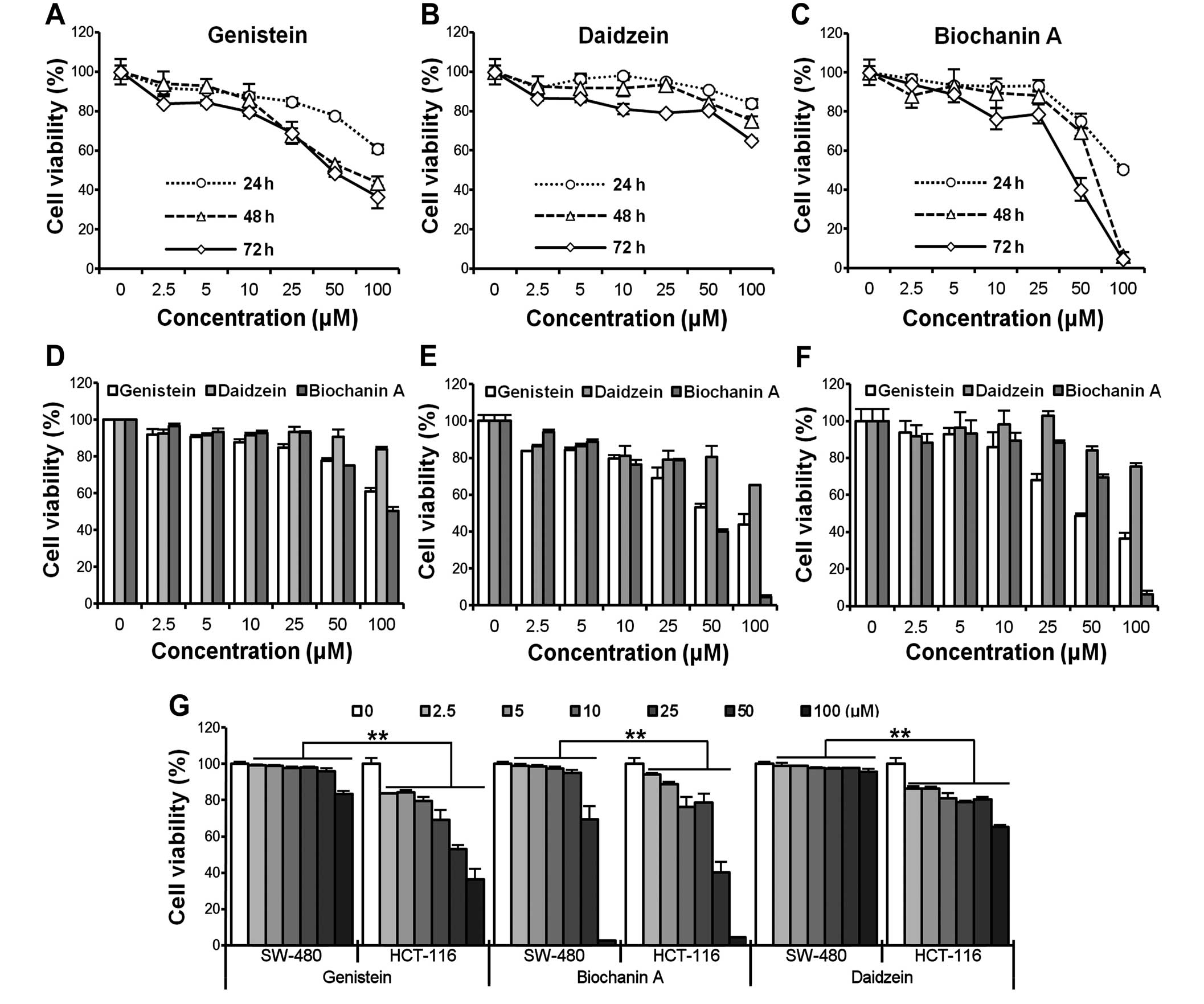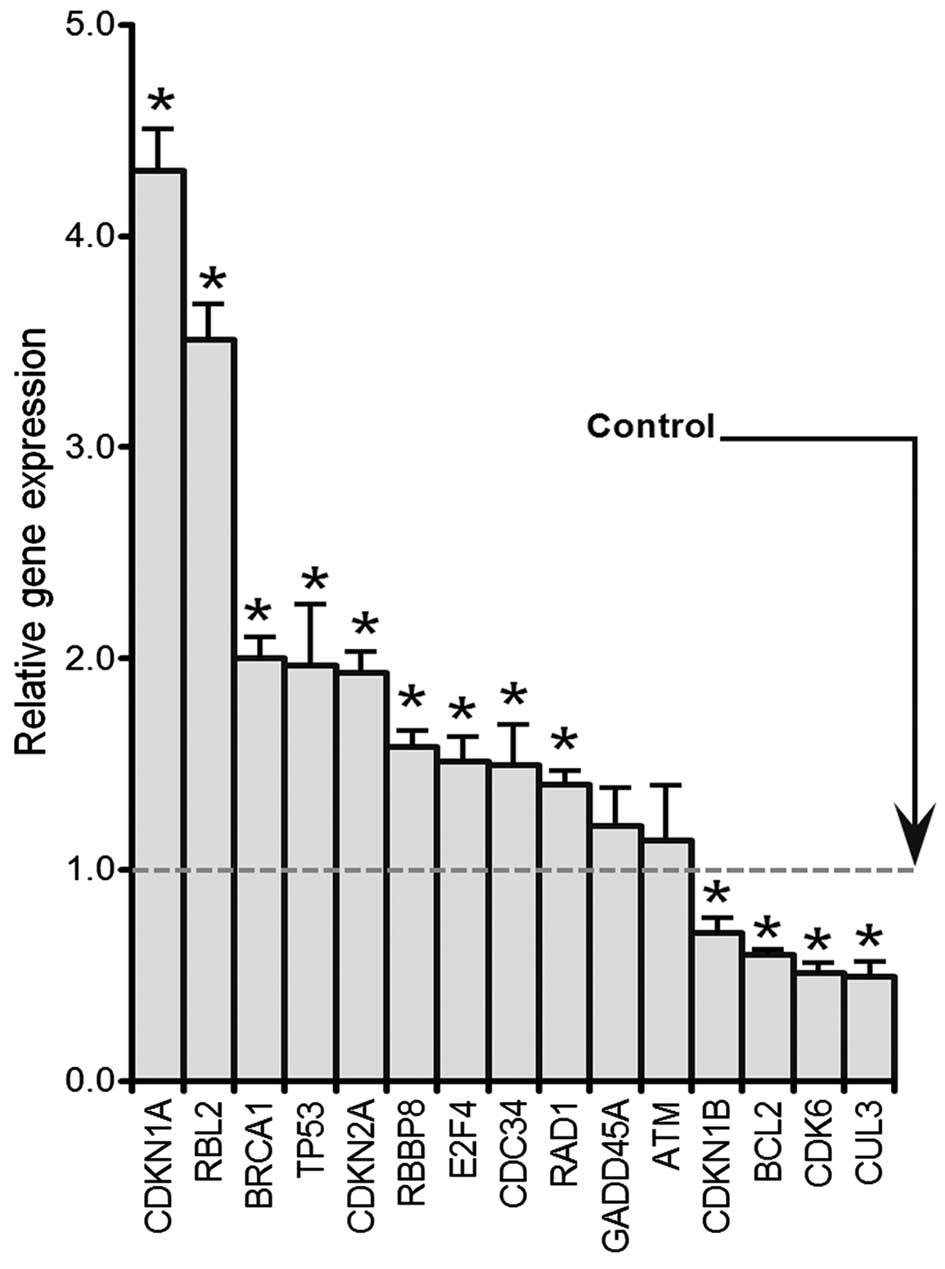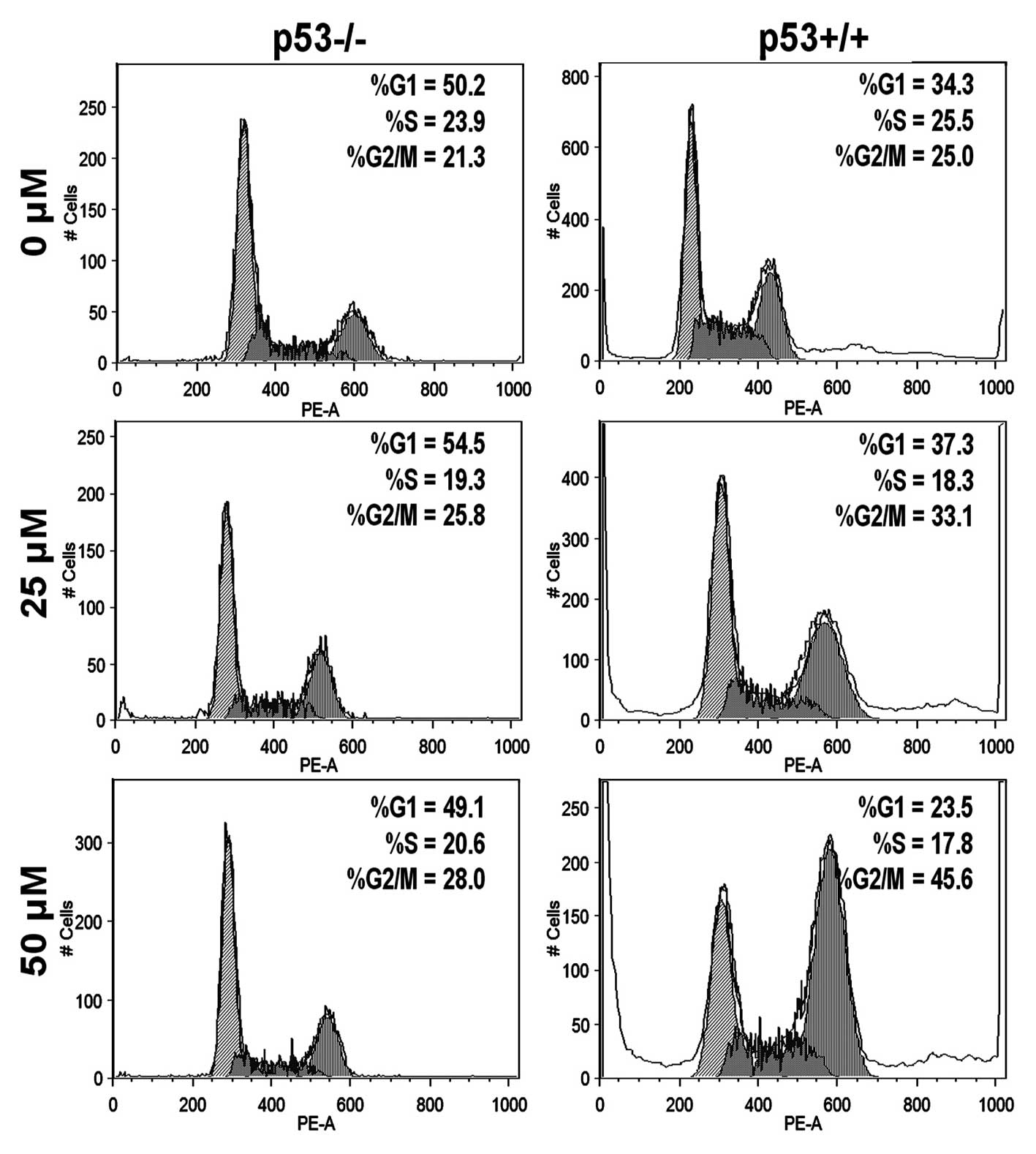|
1.
|
Arber N and Levin B: Chemoprevention of
colorectal cancer: ready for routine use? Recent Results Cancer
Res. 166:213–230. 2005. View Article : Google Scholar : PubMed/NCBI
|
|
2.
|
Rodriguez M, Du GJ, Wang CZ and Yuan CS:
Letter to the editor: Panaxadiol’s anticancer activity is enhanced
by epicatechin. Am J Chin Med. 38:1233–1235. 2010.PubMed/NCBI
|
|
3.
|
Jemal A, Siegel R, Ward E, Hao Y, Xu J and
Thun MJ: Cancer statistics, 2009. CA Cancer J Clin. 59:225–249.
2009. View Article : Google Scholar
|
|
4.
|
Wils J, O’Dwyer P and Labianca R: Adjuvant
treatment of colorectal cancer at the turn of the century: European
and US perspectives. Ann Oncol. 12:13–22. 2001. View Article : Google Scholar : PubMed/NCBI
|
|
5.
|
Segal NH and Saltz LB: Evolving treatment
of advanced colon cancer. Annu Rev Med. 60:207–219. 2009.
View Article : Google Scholar
|
|
6.
|
Thomasset SC, Berry DP, Garcea G, Marczylo
T, Steward WP and Gescher AJ: Dietary polyphenolic phytochemicals -
promising cancer chemopreventive agents in humans? A review of
their clinical properties. Int J Cancer. 120:451–458. 2007.
View Article : Google Scholar
|
|
7.
|
Doll R and Peto R: The causes of cancer:
quantitative estimates of avoidable risks of cancer in the United
States today. J Natl Cancer Inst. 66:1191–1308. 1981.PubMed/NCBI
|
|
8.
|
Umthong S, Puthong S and Chanchao C:
Trigona laeviceps propolis from Thailand: antimicrobial,
antiproliferative and cytotoxic activities. Am J Chin Med.
37:855–865. 2009. View Article : Google Scholar : PubMed/NCBI
|
|
9.
|
Fournier DB, Erdman JW Jr and Gordon GB:
Soy, its components and cancer prevention: a review of the in
vitro, animal and human data. Cancer Epidemiol Biomarkers Prev.
7:1055–1065. 1998.PubMed/NCBI
|
|
10.
|
Kao TH, Chien JT and Chen BH: Extraction
yield of isoflavones from soybean cake as affected by sovlent and
supercritical carbon dioxide. Food Chem. 107:1728–1736. 2008.
View Article : Google Scholar
|
|
11.
|
Banerjee S, Li Y, Wang Z and Sarkar FH:
Multi-targeted therapy of cancer by genistein. Cancer Lett.
269:226–242. 2008. View Article : Google Scholar : PubMed/NCBI
|
|
12.
|
Hartwell LH and Kastan MB: Cell cycle
control and cancer. Science. 266:1821–1828. 1994. View Article : Google Scholar : PubMed/NCBI
|
|
13.
|
Igney FH and Krammer PH: Death and
anti-death: tumour resistance to apoptosis. Nat Rev Cancer.
2:277–288. 2002. View
Article : Google Scholar : PubMed/NCBI
|
|
14.
|
Agarwal MK, Hastak K, Jackson MW, Breit
SN, Stark GR and Agarwal ML: Macrophage inhibitory cytokine 1
mediates a p53-dependent protective arrest in S phase in response
to starvation for DNA precursors. Proc Natl Acad Sci USA.
103:16278–16283. 2006. View Article : Google Scholar : PubMed/NCBI
|
|
15.
|
Liu BP, Chong EY, Cheung FW, Duan JA, Che
CT and Liu WK: Tangutorine induces p21 expression and abnormal
mitosis in human colon cancer HT-29 cells. Biochem Pharmacol.
70:287–299. 2005. View Article : Google Scholar : PubMed/NCBI
|
|
16.
|
Taylor CK, Levy RM, Elliott JC and Burnett
BP: The effect of genistein aglycone on cancer and cancer risk: a
review of in vitro, preclinical and clinical studies. Nutr Rev.
67:398–415. 2009. View Article : Google Scholar : PubMed/NCBI
|
|
17.
|
Schleipen B, Hertrampf T, Fritzemeier KH,
et al: ERbeta-specific agonists and genistein inhibit proliferation
and induce apoptosis in the large and small intestine.
Carcinogenesis. 32:1675–1683. 2011. View Article : Google Scholar : PubMed/NCBI
|
|
18.
|
Vousden KH and Lane DP: p53 in health and
disease. Nat Rev Mol Cell Biol. 8:275–283. 2007. View Article : Google Scholar
|
|
19.
|
Luo X, Chen J, Song WX, et al: Osteogenic
BMPs promote tumor growth of human osteosarcomas that harbor
differentiation defects. Lab Invest. 88:1264–1277. 2008. View Article : Google Scholar : PubMed/NCBI
|
|
20.
|
Kim EJ, Shin HK and Park JH: Genistein
inhibits insulin-like growth factor-I receptor signaling in HT-29
human colon cancer cells: a possible mechanism of the growth
inhibitory effect of Genistein. J Med Food. 8:431–438. 2005.
View Article : Google Scholar
|
|
21.
|
Meloche S and Pouyssegur J: The ERK1/2
mitogen-activated protein kinase pathway as a master regulator of
the G1- to S-phase transition. Oncogene. 26:3227–3239. 2007.
View Article : Google Scholar : PubMed/NCBI
|
|
22.
|
Yu ZL, Li WJ and Liu FY: Inhibition of
proliferation and induction of apoptosis by genistein in colon
cancer HT-29 cells. Cancer Lett. 215:159–166. 2004. View Article : Google Scholar : PubMed/NCBI
|
|
23.
|
Park JH, Oh EJ, Choi YH, et al:
Synergistic effects of dexamethasone and genistein on the
expression of Cdk inhibitor p21(WAF1/CIP1) in human hepatocellular
and colorectal carcinoma cells. Int J Oncol. 18:997–1002.
2001.PubMed/NCBI
|
|
24.
|
Vousden KH and Lu X: Live or let die: the
cell’s response to p53. Nat Rev Cancer. 2:594–604. 2002.
|
|
25.
|
Qi W, Weber CR, Wasland K and Savkovic SD:
Genistein inhibits proliferation of colon cancer cells by
attenuating a negative effect of epidermal growth factor on tumor
suppressor FOXO3 activity. BMC Cancer. 11:2192011. View Article : Google Scholar : PubMed/NCBI
|
|
26.
|
Zhou BB and Elledge SJ: The DNA damage
response: putting checkpoints in perspective. Nature. 408:433–439.
2000. View
Article : Google Scholar : PubMed/NCBI
|
|
27.
|
Schar P: Spontaneous DNA damage, genome
instability and cancer--when DNA replication escapes control. Cell.
104:329–332. 2001. View Article : Google Scholar : PubMed/NCBI
|
|
28.
|
Hoeijmakers JH: Genome maintenance
mechanisms for preventing cancer. Nature. 411:366–374. 2001.
View Article : Google Scholar : PubMed/NCBI
|
|
29.
|
Rouse J and Jackson SP: Interfaces between
the detection, signaling and repair of DNA damage. Science.
297:547–551. 2002. View Article : Google Scholar : PubMed/NCBI
|
|
30.
|
Lee SW, Fang L, Igarashi M, Ouchi T, Lu KP
and Aaronson SA: Sustained activation of Ras/Raf/mitogen-activated
protein kinase cascade by the tumor suppressor p53. Proc Natl Acad
Sci USA. 97:8302–8305. 2000. View Article : Google Scholar : PubMed/NCBI
|
|
31.
|
Tang J and Chu G: Xeroderma pigmentosum
complementation group E and UV-damaged DNA-binding protein. DNA
Repair. 1:601–616. 2002. View Article : Google Scholar : PubMed/NCBI
|
|
32.
|
Levine AJ and Oren M: The first 30 years
of p53: growing ever more complex. Nat Rev Cancer. 9:749–758.
2009.PubMed/NCBI
|
|
33.
|
Toledo F and Wahl GM: Regulating the p53
pathway: in vitro hypotheses, in vivo veritas. Nat Rev Cancer.
6:909–923. 2006. View Article : Google Scholar : PubMed/NCBI
|
|
34.
|
Riley T, Sontag E, Chen P and Levine A:
Transcriptional control of human p53-regulated genes. Nat Rev Mol
Cell Biol. 9:402–412. 2008. View Article : Google Scholar : PubMed/NCBI
|
|
35.
|
Chen Z, Trotman LC, Shaffer D, et al:
Crucial role of p53-dependent cellular senescence in suppression of
Pten-deficient tumorigenesis. Nature. 436:725–730. 2005. View Article : Google Scholar : PubMed/NCBI
|
|
36.
|
Fridman JS and Lowe SW: Control of
apoptosis by p53. Oncogene. 22:9030–9040. 2003. View Article : Google Scholar : PubMed/NCBI
|
|
37.
|
Hoglund P: DNA damage and tumor
surveillance: one trigger for two pathways. Sci STKE.
2006:pe22006.PubMed/NCBI
|
|
38.
|
Wang D and Lippard SJ: Cellular processing
of platinum anti-cancer drugs. Nat Rev Drug Discov. 4:307–320.
2005. View Article : Google Scholar
|
|
39.
|
Abraham RT: Cell cycle checkpoint
signaling through the ATM and ATR kinases. Genes Dev. 15:2177–2196.
2001. View Article : Google Scholar : PubMed/NCBI
|
















